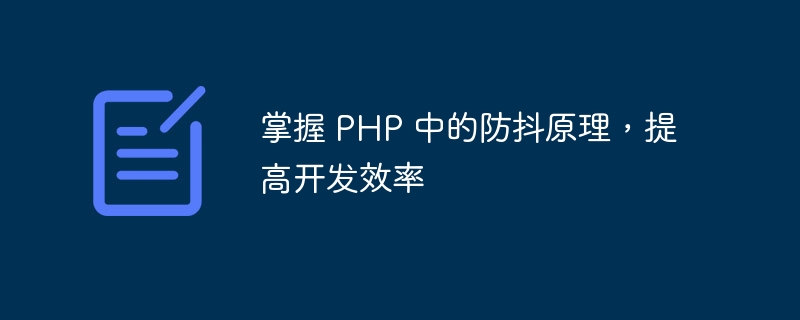Home >Backend Development >PHP Tutorial >Master the anti-shake principle in PHP and improve development efficiency
Master the anti-shake principle in PHP and improve development efficiency
- WBOYWBOYWBOYWBOYWBOYWBOYWBOYWBOYWBOYWBOYWBOYWBOYWBOriginal
- 2023-10-12 10:02:08731browse

Master the anti-shake principle in PHP and improve development efficiency
During the development process, we often encounter situations where we need to prevent users from triggering an event frequently. For example, when the user inputs keywords automatically, if the user inputs multiple characters continuously, search requests will be sent frequently, causing unnecessary performance overhead. At this time, we can use the anti-shake principle to solve this problem.
Anti-shake means that if multiple events are triggered continuously within a certain time interval, only the last event will be executed. It can effectively reduce unnecessary request sending and improve the response speed of the website.
Let’s implement an anti-shake function in detail, written in PHP language.
<?php
function debounce($callback, $delay) {
$timer = null;
return function () use($callback, $delay, &$timer) {
if ($timer) {
clearTimeout($timer);
}
$timer = setTimeout(function () use($callback) {
$callback();
}, $delay);
};
}
// 示例:搜索框输入关键字时的防抖函数应用
function search($keyword) {
// 实际的搜索逻辑
echo "正在搜索关键词:$keyword";
}
// 创建防抖函数
$debouncedSearch = debounce('search', 300); // 延时设定为300毫秒
// 用户输入时调用防抖函数
$keyword = $_GET['keyword'];
$debouncedSearch($keyword);
?>In the above example code, we first define a debounce function, which accepts two parameters. The first parameter is the callback function to be executed, and the second parameter is time interval. Inside the debounce function, we use a closure function and use PHP’s use keyword to reference variables.
Inside the closure function, we first determine whether there is a timer $timer, and if it exists, clear the timer. Then, we use the setTimeout function to create a new timer and execute the callback function after the specified interval.
In our example, we use the anti-shake function application when entering keywords in the search box. First, we create a function called search which represents the actual search logic. Then, we used the debounce function to create a debounce function named $debouncedSearch, which set the delay time to 300 milliseconds.
Finally, when the user enters a keyword, we call the debounce function $debouncedSearch, pass the entered keyword as a parameter, and execute the search logic. Due to the existence of the anti-shake function, when the user continuously enters keywords, only the last input will trigger the search logic.
By mastering the anti-shake principle in PHP, we can effectively improve development efficiency, reduce unnecessary request sending, and optimize website performance. In actual projects, we can flexibly use anti-shake functions according to needs to improve user experience.
The above is the detailed content of Master the anti-shake principle in PHP and improve development efficiency. For more information, please follow other related articles on the PHP Chinese website!

